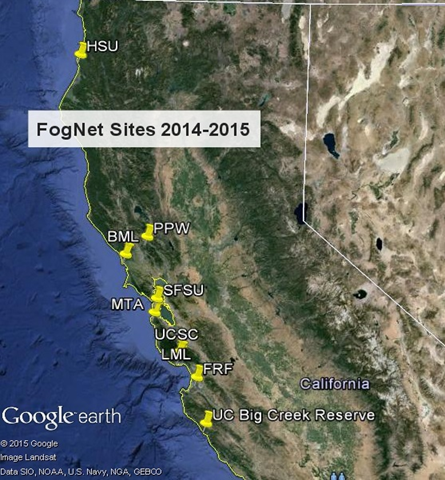
FogNet was a collaborative effort between UC Santa Cruz, Moss Landing Marine Laboratories, CSU Monterey Bay, Humboldt State Marine Labs, Bodega Bay Marine Labs, San Francisco State University, Pepperwood Preserve and US Geological Survey, between the years 2013-2017. It was funded by the National Science Foundation Chemical Oceanography Program.
The goal was collect fog water during summer advective fog events for the chemical characterization using an active fog collector, and to quantify fog deposition volume using a standard passive fog collector. The main chemical constituent we were interested in fog water was mercury, in its most toxic form monomethyl mercury (MMHg). The hypothesis we tested is whether a volatile form of mercury (dimethyl mercury) produced in the coastal ocean can evade the sea water and be incorporated into cloud droplets, whereby it can deposit to terrestrial ecosystems and become an important, or even dominant contributor to MMHg to these environments.
Fog water samples were collected at 7 sites during the summers of 2014-2016: (south to north) Marina Airport, Long Marine Lab, UC Santa Cruz, Montara Lighthouse, Bodega Bay, Pepperwood Preserve, and Humboldt Marine Labs.
Results of this study were published: Weiss-Penzias et al., 2016; Weiss-Penzias et al., 2017; Weiss-Penzias et al., 2018; Weiss-Penzias et al., 2019; Coale et al., 2018; Fernandez et al., 2018
Hi there,
I am a designer and artist living in San Francisco, and recently heard about the trials you were conducting around fog capture. I wanted to find out more about your research and see if you might be able to advise me on materials for a series of sculptures I am working on. Please let me know if there is someone I can talk with about this. Thanks very much!
Jessica Miller
I saw an article on your work in the Santa Cruz Good Times issue of October 14. Great article.
I am interested in the amount of moisture that is collected in fog events. I am particularly interested in the amounts of fog precipitation based on the surface area of the plant material. for example, Quercus Agrifolia, Sequoia Sempervirens, and Coarse fescue turfgrass (4″ ht.) My observations lead me to believe that significantly more water is collected on turfgrass. Is there any data that you could direct me to?
Scott McGilvray
Wateraware